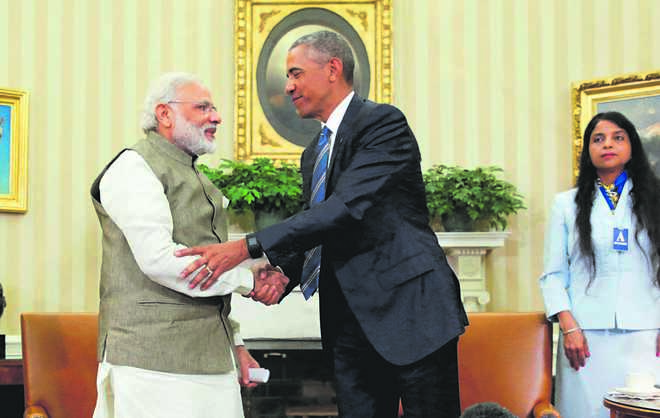
Hands-on: The pro-American swing has confirmed that India needs the US.
PRIME Minister Narendra Modi’s last visit to the United States during the presidency of Mr Barack Obama was notable on many counts. But its most significant aspect was that never before, except for an anguished plea in the 1962 conflict with China, has New Delhi proclaimed its wish for a defence relationship with Washington in such clear terms.The age of non-alignment was dead and gone long before Mr Modi assumed office, but for the first time India has made it clear that she was militarily aligned with the US to safeguard her national interests. Membership of the Nuclear Suppliers Group remains on the wish list but the most symbolic act of the Prime Minister was the laying of a wreath at Arlington cemetery for the American war dead in the many wars they fought.Besides, Mr Modi scored a personal triumph in addressing the joint session of the US Congress, an organisation that had denied him a visa for nearly a decade following the pogrom in Gujarat during his chief ministership. There was a parallel Congressional hearing on India’s human rights record during the Prime Minister’s visit, but it was clear that the US establishment was willing to look the other way — as it had done with so many of its partners earlier — in view of its stakes in enlisting India for larger geopolitical purposes.The motive for India’s swing towards the US is determined by similar reasons. In view of China’s assertive regional policy, particularly by using Pakistan as a cat’s paw, New Delhi has felt it had no option but to rely on the US, still the most powerful nation in the world, to balance Beijing’s growing power.For a change, Mr Modi was forced to praise the Congress government for the landmark nuclear deal Dr Manmohan Singh had signed. The first fruit of this deal was in the agreement by Westinghouse to install nuclear plants in India, although all the loose ends will be tied only in a year from now. On the environment, India has resisted setting out a precise framework in line with the Paris consensus, although Mr Modi has an ambitious plan for renewable energy.India obviously hopes, also by signing the agreement on the mutual use of military bases, that given the range of understandings, she will receive dual-use military equipment and advanced weaponry which could also help in Mr Modi’s ‘Make in India’ credo. What the Washington establishment has welcomed most of all is the Prime Minister’s acknowledgement of the new nature of the relationship with Washington without the inhibitions of the Congress leadership in publishing it. Mr Modi’s preference is to call a spade a spade.One of the Prime Minister’s aims during his visit was to woo the business community to invest in India although he seems to have drawn red lines as far as labour and land reforms are concerned. His sales pitch was India was the fastest growing major economy at a time China’s growth has stalled after piling his usual insults on the preceding Congress governments. He has promised to continue to improve ease of doing business and introduce other reforms.The themes of Mr Modi’s address to the US Congress were balanced between extolling the familiar credo of shared democratic values mixed with using India’s growth engine for the good of America and the world and a thrust for tackling the evil of terrorism in the tough neighbourhood (an oblique criticism of Pakistan). In short, there were no real surprises, although he was wise to talk in his trademark Indian English with a sing-song intonation, rather than resort to Hindi, in seeking to bond with American legislators.In sum, Mr Modi can regard his American visit a success, although the future of Indo-US relations will be determined in part by a future President in a particularly contentious domestic environment with an acute public dissatisfaction among the middle class and poor whites on stagnant wages and on unemployment levels, which has given rise to the phenomenon of Donald Trump. Mercifully, Democrat and Republican legislators desire good relations with India.Given the decisive pro-US swing in India’s worldview, the Prime Minister will have to flesh out the consequences of this pronounced change. Sino-Indian relations will not be much affected because unlike Indians’ propensity to sentimentality, Beijing follows a cynical foreign policy determined by its national interests. Apart from the string of border disputes, which lie frozen, China is an important economic partner and Mr Modi’s effort has been to encourage major Chinese investment in India.India’s dilemmas are many. Despite Mr Modi’s initial efforts to befriend neighbours, Pakistan remains hostile, Nepal has its domestic compulsions in its attitude to New Delhi. True, relations with Bangladesh are better than they have been in a long time and exchanges with Sri Lanka have improved with the change in the island’s presidency. Essentially, New Delhi will have to live among difficult neighbours even as it strikes out to engage countries farther in geographical terms.Mr Modi has also to contend with domestic problems despite his joy in travelling around the world with a copious wardrobe of Nehru jackets in striking colours with colourful multicolour handkerchiefs peeping out of the breast pocket. His monogrammed suit with his name woven into the stripes was auctioned.With the government’s mentor, the RSS, laying down the ideological line for the ruling BJP, Mr Modi’s autonomy in decision-making is restricted. And the Sangh Parivar’s anti-Muslim obsession, with the Bajrang Dal recently enforcing an unofficial ban on cow transport in Uttar Pradesh, the Union Government’s problems will grow.American legislators have already pointed to the insecurity Muslims and Christians feel with the advent of the Modi dispensation. But the danger is in the spillover effect of the anti-minority bias of the Sangh Parivar on relations with important Muslim countries Mr Modi has visited in recent times.However, Mr Modi can gain some satisfaction from his American excursion in setting a new paradigm in Indo-US relations.
